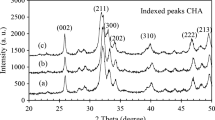Abstract
Carbonate-substituted hydroxyapatites containing up to 9 wt % of carbonate groups were synthesized and fabricated in the form of porous granules with a view to developing materials for use in bone tissue repairs. The use of sintering additives forming a liquid phase allowed the granule sintering temperature to be reduced by 400–450°C. It was found that the carbonate groups enter into the structure of the ceramic by a mixed AB-type substitution; the microstructure of the granules depends substantially on the concentration of the carbonate groups; introduction of 6 wt % of carbonate groups into apatite ensures high biological properties of the granules in experiments in vivo.
Similar content being viewed by others
References
LeGeros, R.Z., Tung, M.S., Chemica Stability of Carbonate- and Fluoride-Containing Apatites, Caries Res., 1983, vol. 17, pp. 419–429.
Dziedzic, D.M., Savva, I.H., Wilkinson, D.S., Davies, J.E., Osteoconduction on, and Bonding to, Calcium Phosphate Ceramic Implants, Proc. Symp. Mater. Res. Soc., 1996, vol. 414, pp. 147–156.
Hasegava, M., Sudo, A., Komlev, V.S., et al. High Release of Antibiotic from a Novel Hydroxyapatite with Bimodal Pore Size Distribution, Biomed. Mater. Res., Part B: Appl. Biomater., 2004, vol. 70, pp. 332–339.
Komlev, V.S., Barinov, S.M., Porous Hydroxyapatite Ceramics of Bi-Modal Pore Size Distribution, J. Mater. Sci.: Mater. Med., 2002, vol. 13, pp. 295–299.
Komlev, V.S., Peryn, F., Mastrogiacomo, M. et al, Kinetics of in ivo Bone Deposition by Bone Marrow Stromal Cells into Porous Calcium Phosphate Scaffolds; an x-ray Computed Microtomography Study, Tissue Eng., 2006, vol. 12, pp. 3449–3458.
Ong, J.L., Hoppe, C.A., Cardenas, H.L. et al., Osteoblast Cell Activity on HA surfaces of Different Treatments, J. Biomed. Mater. Res., 1998, vol. 39, pp. 176–183.
Barinov, S.M., Komlev, V.S., Biokeramika na osnove fosfatov kal’tsiya (Bioceramic Based on Calcium Phosphate), Moscow: Nauka, 2005.
Murugan, R., Sampath, T., Yang, F., Ramakrishna, S., Hydroxyl Carbonapatite Hybrid Bone Composites Using Carbohydrate Polymer, J. Compos. Mater., 2005, vol. 39, pp. 1159–1166.
LeGeros, R.Z., Trautz, O.R., LeGeros, J.P. et al., Apatite Crystallites: Effects of Carbonate on Morphology, Science, 1967, vol. 155, pp. 1409–1411.
Porter, A., Patel, N., Brooks, R. et al., Effect of Carbonate Substitution on the Ultrastructural Characteristics of Hydroxyapatite Implants, J. Mater. Sci. Mater. Med., 2005, vol. 16., pp. 899–907.
Kruyt, M.C., de Bruijn, J.D., Yuan, H. et al., Optimization of Bone Tissue Engineering in Goats: a Perforative Seeding Method Using Cryopreserved Cells and Localized Bone Formation in Calcium Phosphate Scaffolds, Transplantation, 2004, vol. 77, pp. 359–365.
Radin, S.R., Ducheyne, P., The Effect of Calcium-Phosphate Ceramic Composition and Structure on in vitro Behavior. II. Precipitation, J. Biomed. Mater. Res., 1993, vol. 27, pp. 35–45.
Hing, K., Bone Repair in the Twenty-First Century: Biology, Chemistry of Engineering? Phil. Trans. R. Soc. London A, 2004, vol. 362, pp. 2821–2850.
Merry, J.C., Gibson, I.R., Best, S.M. et al., Synthesis and Characterization of Porous Hydroxyapatite, J. Mater. Sci. Mater. Med., 1998, vol. 9, no. 12, pp. 779–783.
Tsuruga, E., Takita, H., Itoh, H. et al., Pore Size of Porous Hydroxyapatite as the Cell-Substratum Controls BMP-Induced Osteogenesis, J. Biochem., 1997, vol. 121, pp. 317–324.
Author information
Authors and Affiliations
Corresponding author
Additional information
Original Russian Text © V.S. Komlev, I.V. Fadeeva, A.N. Gurin, E.S. Kovaleva, V.V. Smirnov, N.A. Gurin, S.M. Barinov, 2009, published in Neorganicheskie Materialy, 2009, Vol. 45, No. 3, pp. 373–378.
Rights and permissions
About this article
Cite this article
Komlev, V.S., Fadeeva, I.V., Gurin, A.N. et al. Effect of the concentration of carbonate groups in a carbonate hydroxyapatite ceramic on its in vivo behavior. Inorg Mater 45, 329–334 (2009). https://doi.org/10.1134/S0020168509030194
Received:
Published:
Issue Date:
DOI: https://doi.org/10.1134/S0020168509030194




